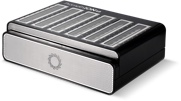Hereditary Cancer Panel (HCP) (HCP_9227_v114_revB_15Oct2025)
PromethION: Protocol
Hereditary Cancer Panel (HCP) V HCP_9227_v114_revB_15Oct2025
This is an end-to-end method outlining sample extraction, library preparation, sequencing, and data analysis.
The protocol:
- Uses genomic DNA extracted from whole blood
- Requires no PCR
- Is compatible with R10.4.1 flow cells
For Research Use Only
FOR RESEARCH USE ONLY
Contents
Introduction to the protocol
- 1. Overview of the protocol
- 2. Before getting started: Data bundle and workflow setup
- 3. Equipment and consumables
Sample preparation
Library preparation
- 6. DNA repair and end-prep
- 7. Native barcode ligation
- 8. Sequencing adapter ligation and clean-up
- 9. Priming and loading the PromethION Flow Cell
Sequencing and data analysis
Troubleshooting
概要
This is an end-to-end method outlining sample extraction, library preparation, sequencing, and data analysis.
The protocol:
- Uses genomic DNA extracted from whole blood
- Requires no PCR
- Is compatible with R10.4.1 flow cells
For Research Use Only
1. Overview of the protocol
Introduction to the Hereditary Cancer Panel (HCP) protocol
This protocol describes the process for DNA extraction, library preparation, and analysis for the Hereditary Cancer Panel (HCP) for 3 samples per PromethION Flow Cell, using the Native Barcoding Kit and the adaptive sampling target enrichment function in MinKNOW. All Oxford Nanopore Technologies supplied reagents required for this protocol are included in the Hereditary Cancer Panel Bundle, available in 18 or 72 sample formats. This bundle includes the Native Barcoding Kit and all necessary sequencing components, and is the standard configuration for implementing this workflow.
Please note, after extraction if processing multiple samples, samples are to be processed in increments of three for library preparation.
Overview of steps in the workflow
Prepare for your experiment
You will need to:
- Extract your input sample (whole blood, DNA).
- Ensure you have your sequencing kit, the correct equipment, and third-party reagents.
- Download the software for acquiring and analysing your data.
- Check your flow cell to ensure it has enough pores for a good sequencing run.
Sample preparation, library preparation, and sequencing
| Step in workflow | Process | Time | Stop option |
|---|---|---|---|
| Sample preparation | Extract gDNA from sample and quantify. Fragment the gDNA and quantify. Check the length, quantity and purity of your extracted material. The quality checks performed during the protocol are recommended to ensure experimental success. | 4 to 6 hours | At this stage, the extracted gDNA or fragmented gDNA can be stored at –20°C for later use. |
| DNA repair and end-prep | Repair the gDNA, and prepare the DNA ends for adapter attachment. | 60 minutes | 4°C overnight |
| Native barcode ligation | Ligate the native barcodes to the DNA ends. | 70 minutes | 4°C overnight |
| Sequencing adapter ligation and clean-up | Ligate sequencing adapters to the DNA ends. | 60 minutes | 4°C for short-term storage or for repeated use, such as for reloading your flow cell. –80°C for long-term storage. |
| Priming and loading the flow cell | Prime the flow cell, and load your DNA library into the flow cell. | 10 minutes | |
| Sequencing | Sequence your library using your sequencing device. | 72 hours | |
| Data analysis | Analysis using HCP data bundle. | 120 minutes |
Compatibility of this protocol
This protocol should only be used in combination with:
- Hereditary cancer panel bundle
- PromethION 24 - PromethION IT requirements document
- PromethION 2 Integrated - PromethION 2 Integrated IT requirements document
2. Before getting started: Data bundle and workflow setup
Data bundle and workflow setup
Following the Hereditary cancer profiling (HCP) registration, a link will be provided by email to a file storage location containing the data bundle to initiate and analyse your sequencing run. This data bundle is specifically configured for this product and ensures consistent setup and compatibility. Instructions for installing the 2ME file in EPI2ME, including how to test it with demo data, are provided in the data analysis section of this protocol.
The data bundle contains:
Hereditary Cancer adaptive sampling files for MinKNOW (reference genome FASTA, target region BED file) to be used during sequencing for target enrichment.
Hereditary Cancer analysis workflow files for post-sequencing bioinformatic analysis in EPI2ME (2ME).
Example files
If you have purchased the Hereditary Cancer bundle, and you have not received an email from the Oxford Nanopore CloudHub platform with a secure link to the required Data Bundle files, please contact our Support Team (support@nanoporetech.com) with your order ID and we will work to provide you with the required invitation.
3. Equipment and consumables
材料
- (FOR EXTRACTION) ≥ 1 ml of human blood in EDTA K2 vacuum tube
- (FOR LIBRARY PREPARATION) ~1 µg of sheared gDNA
- Hereditary Cancer Panel bundle (HCP18 or HCP72) (containing the materials listed below)
- Native Barcoding Kit 24 V14 (SQK-NBD114.24)
- LFB Expansion (EXP-LFB001)
- SFB Expansion (EXP-SFB001) if using the 72 sample bundle
- PromethION Flow Cell
消耗品
- Puregene Blood Kit (QIAGEN, 158023)
- g-TUBE™ (Covaris, 520079)
- NEBNext FFPE Repair Mix (NEB, M6630)
- NEBNext Ultra II End repair/dA-tailing Module (NEB, E7546)
- NEB Blunt/TA Ligase Master Mix (NEB, M0367)
- NEBNext® Quick Ligation Module (NEB, E6056)
- Nuclease-free water (e.g. ThermoFisher, AM9937)
- nuclease-free waterで調整した 80% エタノール溶液
- Isopropanol, 100% (Fisher Scientific, 10723124)
- TE buffer (10 mM Tris-HCl, 1 mM EDTA, pH 8.0) (Fisher scientific, 10224683)
- Qubit dsDNA BR Assay Kit (Invitrogen, Q32850)
- Agilent Genomic DNA 165 kb Analysis Kit (Agilent, FP-1002-0275)
- Qubit™ Assay Tubes (Invitrogen, Q32856)
- 15 ml Falcon tubes
- 1.5 ml Eppendorf DNA LoBind tubes
- 0.2 ml 薄壁のPCRチューブ
装置
- PromethION device
- PromethION Flow Cell Light Shield
- Rotator mixer (e.g. Hula mixer)
- 1.5 mlエッペンドルフチューブに最適のマグネット式ラック
- Heating block
- Incubator or water bath set at 37°C and 50°C
- 小型遠心機
- ボルテックスミキサー
- サーマルサイクラー
- Centrifuge and rotor suitable for 15 ml Falcon tubes
- Megaruptor 3 (Diagenode, B06010003)
- Wide-bore pipette tips
- P1000 ピペット及びチップ
- P200 ピペットとチップ
- P100 ピペットとチップ
- P20 ピペットとチップ
- P10 ピペットとチップ
- P2 ピペットとチップ
- アイスバケツ(氷入り)
- タイマー
- Qubit蛍光光度計(またはQCチェックのための同等品)
- Agilent Femto Pulse System (or equivalent for read length QC)
Oxford Nanopore Technologies Hereditary Cancer Panel bundle
All Oxford Nanopore Technologies reagents required for this protocol are included in the Hereditary Cancer Panel bundles, available in the Nanopore Store in 18-sample (HCP18) or 72-sample (HCP72) formats.
These bundle include the Native Barcoding Kit and all necessary sequencing components, and are the standard configuration for implementing this workflow.
For more information on specific kit components found within this bundle, please refer to the relevant products found in the Nanopore store page:
The above list of materials, consumables, and equipment is for the extraction method in the sample preparation section, as well as the library preparation section of the protocol. If you have pre-extracted sample(s), you will only require the materials for the library preparation section of this protocol.
For this protocol, the following inputs are required:
Input requirements per sample for the extraction method:
- ≥ 1 ml of human blood in EDTA K2 vacuum tube
Input requirements per sample for the library preparation:
- ~1 µg of sheared gDNA
Input DNA
How to QC your input DNA
It is important that the input DNA meets the quantity and quality requirements. Using too little or too much DNA, or DNA of poor quality (e.g. highly fragmented or containing RNA or chemical contaminants) can affect your library preparation.
For instructions on how to perform quality control of your DNA sample, please read the Input DNA/RNA QC protocol.
Chemical contaminants
Depending on how the DNA is extracted from the raw sample, certain chemical contaminants may remain in the purified DNA, which can affect library preparation efficiency and sequencing quality. Read more about contaminants on the Contaminants page of the Community.
Eppendorf tube orientation in centrifuge
For all centrifugation steps, ensure that tubes are loaded into the centrifuge with the hinge side of the tube facing outwards. This will assist in visual identification of the pellet.
Ensure gentle handling when removing the tubes from the centrifuge to avoid dislodging the pellet.

Third-party reagents
We have validated and recommend the use of all the third-party reagents used in this protocol. Alternatives have not been tested by Oxford Nanopore Technologies.
For all third-party reagents, we recommend following the manufacturer's instructions to prepare the reagents for use, unless specified in this protocol.
Check your flow cell
We highly recommend that you check the number of pores in your flow cell prior to starting a sequencing experiment. This should be done within 12 weeks of purchasing your PromethION Flow Cells. Oxford Nanopore Technologies will replace any unused flow cell with fewer than the number of pores listed in the Table below, when the result is reported within two days of performing the flow cell check, and when the storage recommendations have been followed. To do the flow cell check, please follow the instructions in the Flow Cell Check document.
| Flow cell | Minimum number of active pores covered by warranty |
|---|---|
| PromethION Flow Cell | 5000 |
The Native Adapter (NA) used in this kit and protocol is not interchangeable with other sequencing adapters.
4. Purification of gDNA from 1 ml of human blood
材料
- ≥ 1 ml of human blood in EDTA K2 vacuum tube
消耗品
- Puregene Blood Kit (QIAGEN, 158023)
- Absorbent material e.g. paper towel or tissues
- nuclease-free waterで調整した 80% エタノール溶液
- TE buffer (10 mM Tris-HCl, 1 mM EDTA, pH 8.0) (Fisher scientific, 10224683)
- Nuclease-free water (e.g. ThermoFisher, AM9937)
- Qubit dsDNA BR Assay Kit (Invitrogen, Q32850)
- Qubit™ Assay Tubes (Invitrogen, Q32856)
- 15 ml Falcon tubes
- 1.5 ml Eppendorf DNA LoBind tubes
装置
- Centrifuge and rotor suitable for 15 ml Falcon tubes
- Incubator or water bath set at 37°C and 50°C
- ボルテックスミキサー
- 小型遠心機
- Qubit蛍光光度計(またはQCチェックのための同等品)
- アイスバケツ(氷入り)
- タイマー
- Wide-bore pipette tips
- P1000 ピペット及びチップ
- P200 ピペットとチップ
- P20 ピペットとチップ
- P10 ピペットとチップ
- P2 ピペットとチップ
オプション装置
- Agilent Femto Pulse System (or equivalent for read length QC)
Prepare your blood sample(s).
- If using fresh blood or blood stored at 4°C, proceed to DNA extraction.
- If using frozen blood, ensure your sample is thawed completely before proceeding.
Dispense 3 ml RBC Lysis Solution into a 15 ml centrifuge tube.
Ensure the blood is mixed well in the EDTA K2 tube, then transfer 1 ml of the blood sample into the tube containing the RBC lysis solution.
Mix by inverting the tube 10 times.
Incubate for 5 minutes at room temperature (15–25°C). Invert at least once during the incubation.
Centrifuge for 2 minutes at 2000 x g to pellet the white blood cells.
Carefully discard the supernatant, ensuring your leave approximately 200 µl of the residual liquid and the white blood cell pellet.
Note: The supernatant can be removed by pipetting or by pouring the volume out on to an absorbent material.
Gently flick the tube and/or pipette mix using a wide bore tip to resuspend the pellet in the residual liquid.
Note: The pellet should be completely dispersed, this greatly facilitates the cell lysis in the next step.
Add 3 ml of Cell Lysis Solution.
Note: Pipette mix gently 10-15 times to lyse the cells and homogenise the solution until no clumps remain. Ensure that the solution is homogenous.
Incubate the reaction at 37°C for 30 minutes.
Note: Ensure the solution is homogenous by the end of the incubation, and no clumps should remain.
If necessary, you can mix the reaction by pipette mixing with a wide bore pipette tip or gently inverting the tube to assist with homogenisation.
Add 15 μl of RNase A solution and incubate the reaction for 15 minutes at 37°C.
Transfer the reaction to ice bucket with ice, and incubate for 3 min to quickly cool the sample.
Add 1 ml of Protein Precipitation Solution to your sample. Pulse vortex the tube twice for 5 seconds.
Centrifuge your sample for 5 minutes at 2000 x g.
Note: The precipitated protein should form a tight, reddish-brown pellet. If the protein pellet is not tight, incubate the tube on ice for 5 minutes and repeat the centrifugation.
Pipette 3 ml of isopropanol into a clean 15 ml falcon tube.
Carefully pour the supernatant from the sample tube into the 15 ml falcon tube containing the isopropanol.
Ensure that the protein pellet is not dislodged during pouring.
Alternatively, the supernatant can also be transferred by pipetting. Please ensure the protein pellet is not disturbed and remains intact when transferring the supernatant.
Note: If at any point the protein pellet is disturbed, repeat the 10 mininute at 2000 x g centrifugation step. Ensure only the clear supernatant is transferred to avoid protein contamination in the final elute.
Gently mix the tube by inverting 50 times until the DNA is visible as threads or a clump.
Centrifuge the tube for 3 minutes at 2000 x g.
Note: Your DNA should be visible as a small white pellet at the bottom of the tube.
Carefully discard the supernatant and drain the tube by inverting on a clean piece of absorbent paper. Ensure the DNA pellet is undisturbed and remains in the tube.
Note: The supernatant can be removed by pipetting or by pouring the volume out on to an absorbent material. Take care as the pellet might be loose and easily dislodged.
Prepare 300 µl of fresh 80% ethanol in nuclease-free water, and place on ice.
Add 300 μl of ice-cold freshly-prepared 80% ethanol to the sample tube. Gently invert the tube several times to wash the DNA pellet.
Transfer the pellet and the full 300 μl volume of ethanol into a new 1.5 ml Eppendorf tube.
Centrifuge the sample tube for 1 minute at 2000 x g.
Carefully discard the supernatant and drain the tube by inverting on a clean piece of absorbent paper. Ensure the DNA pellet is undisturbed and remains in the tube.
Note: The supernatant can be removed by pipetting or by pouring the volume out on to an absorbent material. Take care as the pellet might be loose and easily dislodged.
Leave the lid off the sample tube and air dry the pellet for 1 min.
Note: Avoid over-drying the pellet, ensure it is not dried to the point of cracking.
Add 100 μl of TE buffer (10 mM Tris-HCl, 1 mM EDTA, pH 8.0) to the tube containing the sample pellet. Gently resuspend the pellet by flicking.
Incubate the tube for 2 hours at 50°C, occasionally pipette mixing the whole volume tube contents (100 μl) with a wide-bore pipette tip.
Note: The DNA pellet may take some time to solubilise. Please ensure the solution is homogenous before quantifying.
Optional: Alternatively, this incubation can be performed at room temperature overnight.
Quantify your sample three times using the Qubit dsDNA BR Assay Kit. Ensure the replicate Qubit measurements are consistent before continuing to the next step.
Note: Approximately 10–30 µg of gDNA is expected following sample extraction.
Expected Qubit measurements of 100–300 ng/μl.
If your Qubit measurements are not consistent, this could indicate that the DNA has not been homogeneously resuspended.
If this occurs, we recommend increasing the incubation time, allowing more time for the DNA pellet to solubilise.
Note: The elution can be aided by incubating at 50°C on a thermomixer with gentle agitation at 300 rpm. Alternatively an end-over-end rotating mixer can be used.
Your extracted gDNA can also be analysed using Femto Pulse (Agilent) to check the size and quality.

Example fragment length profile of gDNA extracted from human blood using the Puregene Blood Kit.
Take your extracted gDNA forward into the size selection of gDNA step of this protocol. Alternatively, your sample can be stored at 4°C overnight.
5. gDNA shearing using the Covaris g-TUBE
材料
- >1 µg of extracted gDNA (from previous step)
消耗品
- g-TUBE (Covaris, 520079)
- Nuclease-free water (e.g. ThermoFisher, AM9937)
- Qubit dsDNA BR Assay Kit (Invitrogen, Q32850)
- Qubit™ Assay Tubes (ThermoFisher, Q32856)
- 1.5 ml Eppendorf DNA LoBind tubes
装置
- Eppendorf 5424 centrifuge (or equivalent)
- 小型遠心機
- Agilent Femto Pulse System (or equivalent for read length QC)
- Qubit™ fluorometer (or equivalent for QC check)
- アイスバケツ(氷入り)
- タイマー
- Wide-bore pipette tips
- P1000 ピペット及びチップ
- P200 ピペットとチップ
- P20 ピペットとチップ
- P10 ピペットとチップ
- P2 ピペットとチップ
Prepare the DNA in nuclease-free water:
1. Ensure you have 1 µg of extracted gDNA from sample extraction, and transfer this into a 1.5 ml Eppendorf tube.
2. Adjust the volume to 50 μl with nuclease-free water.
3. Mix thoroughly by pipetting up and down using a wide-bore pipette tip.
4. Spin down briefly in a microfuge.
Transfer 50 μl of the sample into the top of the g-TUBE and screw the cap firmly.
Load the sample tube into the centrifuge, ensuring the instrument is appropriately balanced according to the manufacturers instructions.
Centrifuge your sample as follows:
Note: the speeds may vary depending on the type of centrifuge being used. Please refer to the manufacturer’s manual for further details of your equipment.
1. Centrifuge at 6,000 rpm (3381 RCF) for 60 seconds.
2. Visually inspect to confirm the entire sample has passed through the upper chamber to the lower chamber of the g-TUBE. If the sample has not passed through, then repeat the step until the sample has fully passed into the lower chamber.
3. Remove the tube from the centrifuge, invert the g-TUBE and place it back in the centrifuge (ensuring the volume of sample is in the upper chamber.
4. Spin the g-tube again at the same speed and duration as above: 6,000rpm (3381 RCF) for 60 seconds.
5. Visually inspect to confirm the entire sample has passed through the upper chamber to the lower chamber of the g-TUBE. If the sample has not passed through, then repeat the step until the sample has fully passed into the lower chamber.
Repeat the previous step two more times, for a total of 3 passes through the g-TUBE in each direction.
With the sample volume in the lower chamber, unscrew the g-TUBE body, leaving the screw-cap containing the sample volume.
Retrieve the sample from the g-TUBE screw-cap and transfer it into a clean 1.5 ml Eppendorf tube.
Quantify your sample using the Qubit dsDNA BR Assay Kit.
Note: Approximately 1 µg of gDNA is expected following shearing. Expected Qubit measurements of ~18–20 ng/μl.
The sheared gDNA can also be assessed for fragment size using Femto Pulse (Agilent).
Expected sheared length ~7.5–8.5 kb
Take forward your 48 µl of sheared gDNA into the library preparation section of this protocol. Alternatively, your sample can be stored at 4°C overnight.
6. DNA repair and end-prep
材料
- 1 µg of sheared gDNA in 48 µl (from previous step) for each sample
消耗品
- NEBNext® FFPE DNA Repair Mix (NEB, M6630)
- NEBNext® Ultra™ II End Repair/dA-Tailing Module (NEB, E7546)
- Nuclease-free water (e.g. ThermoFisher, AM9937)
- 0.2 ml 薄壁のPCRチューブ
- 1.5 ml Eppendorf DNA LoBind tubes
装置
- P1000 ピペット及びチップ
- P200 ピペットとチップ
- P100 ピペットとチップ
- P20 ピペットとチップ
- P10 ピペットとチップ
- P2 ピペットとチップ
- Multichannel pipette and tips
- ボルテックスミキサー
- サーマルサイクラー
- 小型遠心機
- アイスバケツ(氷入り)
- Rotator mixer (e.g. Hula mixer)
Prepare the NEBNext FFPE DNA Repair Mix and NEBNext Ultra II End Repair / dA-tailing Module reagents in accordance with manufacturer’s instructions, and place on ice.
For optimal performance, NEB recommend the following:
Thaw all reagents on ice.
Flick and/or invert the reagent tubes to ensure they are well mixed.
Note: Do not vortex the FFPE DNA Repair Mix or Ultra II End Prep Enzyme Mix.Always spin down tubes before opening for the first time each day.
The Ultra II End Prep Reaction Buffer and FFPE DNA Repair Buffer may have precipitate. Allow the mixtures to come to room temperature and pipette the buffers up and down several times to break up the precipitate, followed by vortexing the tubes for 30 seconds to solubilise any precipitate.
Note: It is important the buffers are mixed well by vortexing.The FFPE DNA Repair Buffer may have a yellow tinge.
Do not vortex the NEBNext FFPE DNA Repair Mix or NEBNext Ultra II End Prep Enzyme Mix.
It is important that the NEBNext FFPE DNA Repair Buffer and NEBNext Ultra II End Prep Reaction Buffer are mixed well by vortexing.
Check for any visible precipitate; vortexing for at least 30 seconds may be required to solubilise any precipitate.
Prepare your DNA sample(s):
1. For each sample, ensure you have 48 µl (with ~1 µg) sample in a separate clean 0.2 ml thin-walled PCR tube.
2. Mix each sample thoroughly by pipetting up and down, or by flicking the tube. Spin down briefly in a microfuge.
Combine the following components per tube:
| Reagent | Volume |
|---|---|
| DNA sample | 48 µl |
| Ultra II End-prep Reaction Buffer | 3.5 µl |
| Ultra II End-prep Enzyme Mix | 3 µl |
| NEBNext FFPE DNA Repair Buffer | 3.5 µl |
| NEBNext FFPE DNA Repair Mix | 2 µl |
| Total | 60 µl |
Ensure the components are thoroughly mixed by pipetting and spin down briefly.
Using a thermal cycler with a heated lid, incubate the reaction(s) at 20°C for 5 minutes, 65°C for 5 minutes, and hold at 4°C.
Remove the reaction from the thermal cycler and place the tubes on ice.
At this stage, you can transfer each sample reaction to a separate clean 1.5 ml Eppendorf LoBind tube for ease of handling.
Resuspend the AMPure XP Beads (AXP) by vortexing.
Add a 1X volume (60 µl) of resuspended the AMPure XP Beads (AXP) to each end-prep reaction and mix by flicking the tube.
Incubate on a rotator mixer (e.g. Hula mixer) for 10 minutes at room temperature.
Freshly prepare 2 ml of 80% ethanol in nuclease-free water (this is sufficient to process three samples).
Note: Ensure you prepare sufficient 80% ethanol for all your samples.
Spin down each sample and pellet on a magnet for 10 minutes until supernatant is clear and colourless. Keep the tube(s) on the magnet, and pipette off the supernatant.
Keep the tube(s) on the magnet and wash the beads with 200 µl of freshly prepared 80% ethanol without disturbing the pellet. Remove the ethanol using a pipette and discard.
Repeat the previous step.
Spin down and place the tube back on the magnet. Pipette off any residual ethanol. Allow to dry for ~30 seconds, but do not dry the pellet to the point of cracking.
For each sample, remove the tube from the magnetic rack and resuspend the pellet in 20 µl nuclease-free water. Incubate for 5 minutes at room temperature.
Pellet the beads on a magnet until the eluate is clear and colourless, for at least 1 minute.
For each sample, remove and retain 20 µl of eluate into a separate clean 1.5 ml Eppendorf DNA LoBind tube.
Note: Ensure your samples are processed separately. At this stage, they are not yet barcoded.
Quantify 1 µl of each eluted sample using a Qubit fluorometer.
We recommend performing multiple (triplicate) Qubit readings of each of the 3 samples to quantify them more accurately. This will be essential for further normalising of each sample before barcoding.
Note: You should expect to recover between 500–700 ng per sample after end-prep.
Using your quantification results, normalise your samples to the sample with the lowest yield as follows:
1. Take forward 16 μl of your lowest-performing sample into a clean 0.2 ml thin-walled PCR tube.
2. Take forward an equivalent mass of each of the other samples into separate clean 0.2 ml thin-walled PCR tubes.
3. Adjust the volume of each of the samples to 16 μl using nuclease-free water.
Take forward your end-prepped DNA samples into the native barcode ligation step.
Optional: At this point, you can also store the sample at 4°C overnight.
7. Native barcode ligation
材料
- Native Barcodes (NB01-24)
- AMPure XP Beads (AXP)
- EDTA (EDTA)
- Short Fragment Buffer (SFB)
消耗品
- NEB Blunt/TA Ligase Master Mix (NEB, M0367)
- Nuclease-free water (e.g. ThermoFisher, AM9937)
- 1.5 ml Eppendorf DNA LoBind tubes
- Eppendorf twin.tec® PCR plate 96 LoBind, semi-skirted (Eppendorf™, cat # 0030129504) with heat seals
- Qubit™ Assay Tubes (Invitrogen, Q32856)
- Qubit dsDNA HS Assay Kit (ThermoFisher, Q32851)
装置
- マグネットラック
- ボルテックスミキサー
- Rotator mixer (e.g. Hula mixer)
- 小型遠心機
- サーマルサイクラー
- アイスバケツ(氷入り)
- Multichannel pipette and tips
- P1000 ピペット及びチップ
- P200 ピペットとチップ
- P100 ピペットとチップ
- P20 ピペットとチップ
- P10 ピペットとチップ
- P2 ピペットとチップ
- Qubit蛍光光度計(またはQCチェックのための同等品)
Prepare the NEB Blunt/TA Ligase Master Mix and NEBNext Quick Ligation Module according to the manufacturers instructions, and place on ice.
- Thaw the reagents at room temperature.
- Spin down the reagent tubes for 5 seconds.
- Ensure the reagents are fully mixed by performing 10 full volume pipette mixes.
Thaw the AMPure XP Beads (AXP) at room temperature and mix by vortexing. Keep the beads at room temperature.
Thaw the EDTA at room temperature and mix by vortexing. Then spin down and place on ice.
Thaw the Short Fragment Buffer (SFB) at room temperature and mix by vortexing. Place on ice.
Thaw the Native Barcodes (NB01-24) at room temperature. Individually mix the barcodes by pipetting, spin down, and place them on ice.
The wells of the barcoding plate are intended for single use only. Please ensure your barcode well is sealed before use, and do not reuse the barcode well once pierced/opened.
Select a unique barcode for every sample to be run together on the same flow cell. Up to 3 samples should be barcoded and combined onto one PromethION Flow Cell
Note: Only use one barcode per sample.
Into each 1.5 ml Eppendorf tube containing your normalised sample inputs, add the reagents in the following order per well, mixing well by pipetting between each addition:
| Reagent | Volume |
|---|---|
| End-prepped DNA | 16 µl |
| Native Barcode (NB01-24) | 4 µl |
| Blunt/TA Ligase Master Mix | 20 µl |
| Total | 40 µl |
Thoroughly mix the reaction by gently pipetting and briefly spinning down.
Incubate for 20 minutes at room temperature.
Add the 4 µl of EDTA to each sample tube. Mix thoroughly by pipetting and spin down briefly.
EDTA is added at this step to stop the reaction.
Pool the barcoded samples (up to three samples at a time) in a 1.5 ml Eppendorf DNA LoBind tube.
Resuspend the AMPure XP Beads (AXP) by vortexing.
Add 0.65X volume (88 µl) of AMPure XP Beads (AXP) to the pooled reaction, and mix by pipetting.
Incubate on a rotator mixer (e.g. Hula mixer) for 10 minutes at room temperature.
The next clean-up step uses Short Fragment Buffer (SFB) rather than 80% ethanol to wash the beads.
Using 80% ethanol may result in sub-optimal results.
Spin down the sample and pellet on a magnet for 5 minutes. Keep the plate on the magnetic rack until the eluate is clear and colourless, and pipette off the supernatant.
Wash the beads with 500 µl of Short Fragment Buffer (SFB). Flick the beads to resuspend, spin down , then return the sample to the magnetic rack and allow the beads to pellet. Remove the buffer using a pipette and discard.
Repeat the previous step.
Spin down and place the tube back on the magnetic rack. Pipette off any residual buffer.
Remove the tube from the magnetic rack and resuspend the pellet in 32 µl nuclease-free water by gently flicking.
Incubate for 10 minutes at 37°C. Every 2 minutes, agitate the sample by gently flicking for 10 seconds to encourage DNA elution.
Pellet the beads on a magnetic rack until the eluate is clear and colourless.
Remove and retain 32 µl of eluate into a clean 1.5 ml Eppendorf DNA LoBind tube.
Quantify 1 µl of eluted sample using a Qubit fluorometer.
Note: You should expect to recover between 600–800 ng after native barcoding.
Take forward the barcoded DNA library to the adapter ligation and clean-up step. However, you may store the sample at 4°C overnight.
8. Sequencing adapter ligation and clean-up
材料
- Long Fragment Buffer (LFB)
- Elution Buffer (EB)
- Native Adapter (NA)
- AMPure XP Beads (AXP)
消耗品
- NEBNext® Quick Ligation Module (NEB, E6056)
- 1.5 ml Eppendorf DNA LoBind tubes
- Qubit™ Assay Tubes (Invitrogen, Q32856)
- Qubit dsDNA HS Assay Kit (ThermoFisher, Q32851)
装置
- 小型遠心機
- マグネットラック
- ボルテックスミキサー
- Rotator mixer (e.g. Hula mixer)
- サーマルサイクラー
- P1000 ピペット及びチップ
- P200 ピペットとチップ
- P100 ピペットとチップ
- P20 ピペットとチップ
- P10 ピペットとチップ
- アイスバケツ(氷入り)
- Qubit蛍光光度計(またはQCチェックのための同等品)
The Native Adapter (NA) used in this kit and protocol is not interchangeable with other sequencing adapters.
フローセルのチェックを行ってください。
ライブラリー調製を開始する前にフローセルチェックを行い、良好なシークエンスランに十分なポアを持つフローセルを使用することをお勧めします。
詳細については、MinKNOWプロトコルのflow cell check instructions を参照してください。
Prepare the NEBNext Quick Ligation Reaction Module according to the manufacturer's instructions, and place on ice:
Thaw the reagents at room temperature.
Spin down the reagent tubes for 5 seconds.
Ensure the reagents are fully mixed by performing 10 full volume pipette mixes. Note: Do NOT vortex the Quick T4 DNA Ligase.
The NEBNext Quick Ligation Reaction Buffer (5x) may have a little precipitate. Allow the mixture to come to room temperature and pipette the buffer up and down several times to break up the precipitate, followed by vortexing the tube for several seconds to ensure the reagent is thoroughly mixed.
Do not vortex the Quick T4 DNA Ligase.
Spin down the Native Adapter (NA) and Quick T4 DNA Ligase, pipette mix and place on ice.
Thaw the Elution Buffer (EB) at room temperature and mix by vortexing. Then spin down and place on ice.
Thaw the Long Fragment Buffer (LFB) at room temperature and mix by vortexing. Place on ice.
In a 1.5 ml Eppendorf LoBind tube, mix in the following order:
| Reagent | Volume |
|---|---|
| 3-plex pooled barcoded library | 30 µl |
| Native Adapter (NA) | 5 µl |
| NEBNext Quick Ligation Reaction Buffer (5X) | 10 µl |
| Quick T4 DNA Ligase | 5 µl |
| Total | 50 µl |
Thoroughly mix the reaction by gently pipetting and briefly spinning down.
Incubate the reaction for 20 minutes at room temperature.
The next clean-up step uses Long Fragment Buffer (LFB) rather than 80% ethanol to wash the beads. The use of ethanol will be detrimental to the sequencing reaction.
Resuspend the AMPure XP Beads (AXP) by vortexing.
Add 0.5X volume (25 µl) of resuspended AMPure XP Beads (AXP) to the reaction and mix by pipetting.
Incubate on a rotator mixer (e.g. Hula mixer) for 10 minutes at room temperature.
Spin down the sample and pellet on the magnetic rack. Keep the tube on the magnet and pipette off the supernatant.
Wash the beads by adding 250 μl Long Fragment Buffer (LFB). Flick the beads to resuspend, spin down, then return the tube to the magnetic rack and allow the beads to pellet for at least 5 minutes. Remove the supernatant using a pipette and discard.
Note: Take care when removing the supernatant, the viscosity of the buffer can contribute to loss of beads from the pellet.
Repeat the previous step.
Spin down and place the tube back on the magnet. Pipette off any residual supernatant. Allow to dry for ~30 seconds, but do not dry the pellet to the point of cracking.
Remove the tube from the magnetic rack and resuspend the pellet in 35 µl Elution Buffer (EB).
Spin down and incubate for 10 minutes at 37°C. Every 2 minutes, agitate the sample by gently flicking for 10 seconds to encourage DNA elution.
Pellet the beads on a magnet until the eluate is clear and colourless, for at least 1 minute.
Remove and retain 35 µl of eluate containing the DNA library into a clean 1.5 ml Eppendorf DNA LoBind tube.
Note: Dispose of the pelleted beads
Quantify 1 µl of eluted sample using a Qubit fluorometer.
Note: You should expect to recover between 300–500 ng after adapter ligation.
Note: Loading less than 250 ng on your flow cell could result in lower pore occupancies and not meeting the required target output.
The prepared library is used for loading into the flow cell. Store the library on ice or at 4°C until ready to load.
For this method we recommend loading your flow cell(s) as soon as possible following library preparation.
9. Priming and loading the PromethION Flow Cell
材料
- Flow Cell Flush (FCF)
- Flow Cell Tether (FCT)
- Library Beads (LIB)
- Sequencing Buffer (SB)
消耗品
- PromethION Flow Cell
- 1.5 ml Eppendorf DNA LoBind tubes
装置
- PromethION sequencing device
- Hereditary Cancer Panel adaptive sampling files for MinKNOW (reference genome FASTA, target region BED file)
- PromethION Flow Cell Light Shield
- P1000 ピペット及びチップ
- P200 ピペットとチップ
- P20 ピペットとチップ
This kit is only compatible with R10.4.1 flow cells (FLO-PRO114M).
冷蔵庫からフローセルを取り出した後にフローセルが室温に戻るまで20分待ってからPromethIONに差し込んでください。湿度の高い環境ではフローセルに結露が生じることがあります。フローセルの上面と下面にある金色のコネクターピンに結露がないかを点検し、結露が確認された場合はリントフリーのウェットティッシュで拭き取ってください。フローセル下面にヒートパッド(黒いパッド)があることを確認してください。
Thaw the Sequencing Buffer (SB), Library Beads (LIB), Flow Cell Tether (FCT) and Flow Cell Flush (FCF) at room temperature before mixing by vortexing. Then spin down and store on ice.
Prepare the flow cell priming mix in a suitable tube for the number of flow cells to flush. Once combined, mix well by briefly vortexing.
| Reagent | Volume per flow cell |
|---|---|
| Flow Cell Tether (FCT) | 30 µl |
| Flow Cell Flush (FCF) | 1170 µl |
| Total volume | 1,200 µl |
For the PromethION 24, load the flow cell(s) into the docking ports:
- Line up the flow cell with the connector horizontally and vertically before smoothly inserting into position.
- Press down firmly onto the flow cell and ensure the latch engages and clicks into place.


Insertion of the flow cells at the wrong angle can cause damage to the pins on the PromethION and affect your sequencing results. If you find the pins on a PromethION position are damaged, please contact support@nanoporetech.com for assistance.

Complete a flow cell check to assess the number of pores available before loading the library.
This step can be omitted if the flow cell has been checked previously.
See the flow cell check document for more information.
Slide the inlet port cover clockwise to open.

Take care when drawing back buffer from the flow cell. Do not remove more than 20-30 µl, and make sure that the array of pores are covered by buffer at all times. Introducing air bubbles into the array can irreversibly damage pores.
After opening the inlet port, draw back a small volume to remove any air bubbles:
- Set a P1000 pipette tip to 200 µl.
- Insert the tip into the inlet port.
- Turn the wheel until the dial shows 220-230 µl, or until you see a small volume of buffer entering the pipette tip.

Load 500 µl of the priming mix into the flow cell via the inlet port, avoiding the introduction of air bubbles. Wait five minutes. During this time, prepare the library for loading using the next steps in the protocol.

Thoroughly mix the contents of the Library Beads (LIB) by pipetting.
The Library Beads (LIB) tube contains a suspension of beads. These beads settle very quickly. It is vital that they are mixed immediately before use.
We recommend using the Library Beads (LIB) for most sequencing experiments.
In a new 1.5 ml Eppendorf DNA LoBind tube, prepare the library for loading as follows:
| Reagent | Volume per flow cell |
|---|---|
| Sequencing Buffer (SB) | 100 µl |
| Library Beads (LIB) thoroughly mixed before use | 68 µl |
| DNA library | 32 µl |
| Total | 200 µl |
Note: Library loading volume has been increased to improve array coverage.
Complete the flow cell priming by slowly loading 500 µl of the priming mix into the inlet port.

Mix the prepared library gently by pipetting up and down just prior to loading.
Load 200 µl of library into the inlet port using a P1000 pipette.

Close the valve to seal the inlet port.
For optimal sequencing output, install the light shield on your flow cell as soon as the library has been loaded.
We recommend leaving the light shield on the flow cell when library is loaded, including during any washing and reloading steps. The shield can be removed when the library has been removed from the flow cell.
If the light shield has been removed from the flow cell, install the light shield as follows:
- Align the inlet port cut out of the light shield with the inlet port cover on the flow cell. The leading edge of the light shield should sit above the flow cell ID.
- Firmly press the light shield around the inlet port cover. The inlet port clip will click into place underneath the inlet port cover.


Close the PromethION lid when ready to start a sequencing run on MinKNOW.
Wait a minimum of 10 minutes after loading the flow cells onto the PromethION before initiating any experiments. This will help to increase the sequencing output.
10. Data acquisition and basecalling
How to start sequencing
The sequencing device control, data acquisition and real-time basecalling are carried out by the MinKNOW software.
We recommend basecalling with the high accuracy (HAC) basecaller in real-time with BAM selected as output type using the P24 device.
Refer to the links below containing the detailed instructions for setting up the device and sequencing run:
- PromethION 24: "Starting a sequencing run with PromethION 24"
Below are the recommended sequencing parameters for MinKNOW.
MinKNOW settings for hereditary cancer profiling workflow on PromethION
We strongly recommend using MinKNOW version 25.03.7 for optimal results. Instructions for MinKNOW 25.03.7 rollback can be downloaded here.
Please ensure you have the correct BED files available on your device for data acquisition and analysis.
If you require assistance ensuring you are on the correct version of MinKNOW please contact your Oxford Nanopore Technologies representative.
Setting up your sequencing run in MinKNOW:
- Open the MinKNOW software UI via your desktop application.
- In the MinKNOW UI, you can choose either Start sequencing (option 1) or Start from a sample sheet (option 2).
Option 1: Selecting "Start sequencing"
- Follow the sequencing run set up on-screen using the settings defined below:
Positions
Flow cell position: [user defined]
Experiment name: [user defined]
Flow cell type: FLO-PRO114M
Sample ID: [user defined]
Kit
Kit selection: Native Barcoding Sequencing Kit (SQK-NBD114.24)
Run configuration
Sequencing and analysis
Basecalling: On [default]
Modified bases: On with '5mC & 5hmC CG contexts' selected
Model: High-accuracy basecalling (HAC) [default]
Barcoding: On [default]
Alignment: On
Upload the reference genome file provided in the Hereditary Cancer Panel file pack (HCP_GRCh38_masked_v1.0.fasta) for alignment
Adaptive sampling: On
Enrich: On
Deplete: Off [default]
Barcode balancing: Off [default]
Basecall on-target reads only: Off [default]
Upload the reference genome file (HCP_GRCh38_masked_v1.0.fasta) and target region (HCP_GRCh38_masked_v1.0.bed) provided in the Hereditary Cancer Panel file pack for alignment
Advanced options
Active channel selection: On [default]
Time between pore scans: 1.5 [default]
Reserve pores: On [default]
Data targets
Run limit: 72 hours [default]
Analysis workflow
Workflow: Off [default]
Output
Ensure enough space on your device: minimum of 0.8TB per flow cell.
Output format
.BAM: On [default]
.FASTQ: On [default]
Based on: Time elapsed [default]
Frequency: Every 10 minutes [default]
Barcoding: Split files by barcode: On [default]
FASTQ options: Compression: Off
Raw reads output: On [default]
.POD5: On [default]
.FAST5: Off [default]
Raw reads options: Split .POD5 files by barcode: Off [default]
Filtering: On [default]
Qscore: 9 [default]
Minimum read length: [default]
Max read length: [default]
Option 2: Selecting "Start from a sample sheet"
Starting from a sample sheet (CSV format) enables assigning each barcode a name that will be carried through the analysis (alias column). The sample sheet defines the flow cell (flow_cell_product_code column) and kit (kit column) used. Additionally, a column for experiment (experiment_id column) and either slot number on the device (position_ID) or unique flow cell identifier (position_ID) is requiredIt is compulsory to add a column for either the sequencing slot number on the device( position_ID) or the flow cell unique identifier (flow_cell_ID).
For further information on sample sheet options, see the sample sheet upload section of our MinKNOW documentation.
- Select the sample sheet file from your file system. Please, ensure that your sample sheet name has a visible “.csv” extension for it to be recognised by MinKNOW.
- Follow the sequencing run set up on-screen using the settings defined below:
Positions
Flow cell position: [Defined in sample sheet]
Experiment name: [Defined in sample sheet]
Flow cell type: FLO-PRO114M
Sample ID: [Defined in sample sheet]
Kit
Kit selection: Native Barcoding Sequencing Kit (SQK-NBD114.24)
Run configuration
Sequencing and analysis
Basecalling: On [default]
Modified bases: On with '5mC & 5hmC CG contexts' selected
Model: High-accuracy basecalling (HAC) [default]
Barcoding: On [default]
Alignment: On
Upload the reference genome file provided in the Hereditary Cancer Panel file pack (HCP_GRCh38_masked_v1.0.fasta) for alignment
Adaptive sampling: On
Enrich: On
Deplete: Off [default]
Barcode balancing: Off [default]
Basecall on-target reads only: Off [default]
Upload the reference genome file (HCP_GRCh38_masked_v1.0.fasta) and target region (HCP_GRCh38_masked_v1.0.bed) provided in the Hereditary Cancer Panel file pack for alignment
Advanced options
Active channel selection: On [default]
Time between pore scans: 1.5 [default]
Reserve pores: On [default]
Data targets
Run limit: 72 hours [default]
Analysis workflow
Workflow: Off [default]
Output
Ensure enough space on your device: minimum of 0.8TB per flow cell.
Output format
.BAM: On [default]
.FASTQ: On [default]
Based on: Time elapsed [default]
Frequency: Every 10 minutes [default]
Barcoding: Split files by barcode: On [default]
FASTQ options: Compression: Off
Raw reads output: On [default]
.POD5: On [default]
.FAST5: Off [default]
Raw reads options: Split .POD5 files by barcode: Off [default]
Filtering: On [default]
Qscore: 9 [default]
Minimum read length: [default]
Max read length: [default]
We do not recommend sequencing and performing data analysis simultaneously on your device.
To ensure the compute on your device can keep up with the requirements for sequencing and/or analysis, we strongly recommend against running both processes at the same time.
Ensure your sequencing run has completed before setting off data analysis. Data analysis will be performed post-sequencing.
Equally, we do not recommend starting a sequencing run if you are currently performing data analysis on your device.
11. Downstream analysis
Software and file requirements
The sequencing output files (.bam) can be analysed using wf-hereditary-cancer, a bioinformatics workflow implemented in Nextflow that is part of Oxford Nanopore’s EPI2ME suite of analysis workflows. wf-hereditary-cancer can be run within the EPI2ME Desktop App. To run the analysis, you will need the workflow package (reference genome FASTA, target region BED files, and the workflow itself) distributed separately as a 2ME file.
Please note that we do not recommend sequencing and performing data analysis simultaneously on your device.
Minimum hardware requirements
| Resource | Recommended | Minimum |
|---|---|---|
| CPU | 16 | 8 |
| Memory | 64 GB | 32 GB |
| Storage | 500 GB | 500 GB |
- Approximate run time: ~ 1 hour per sample on a PromethION 24
- ARM processor support: False
- Compatible operating systems: Linux, Windows, Mac* (*M type chips currently not supported).
Before starting analysis
Installing EPI2ME and working directory setup
If not already installed on your device, you can download and install the EPI2ME Desktop App following these instructions. Once installed, click on ‘Settings’ on the main dashboard, and ensure the working directory is set to ‘/data/epi2melabs’ as follows. This will ensure that the files generated by the workflow during analysis do not fill up the system’s home directory:
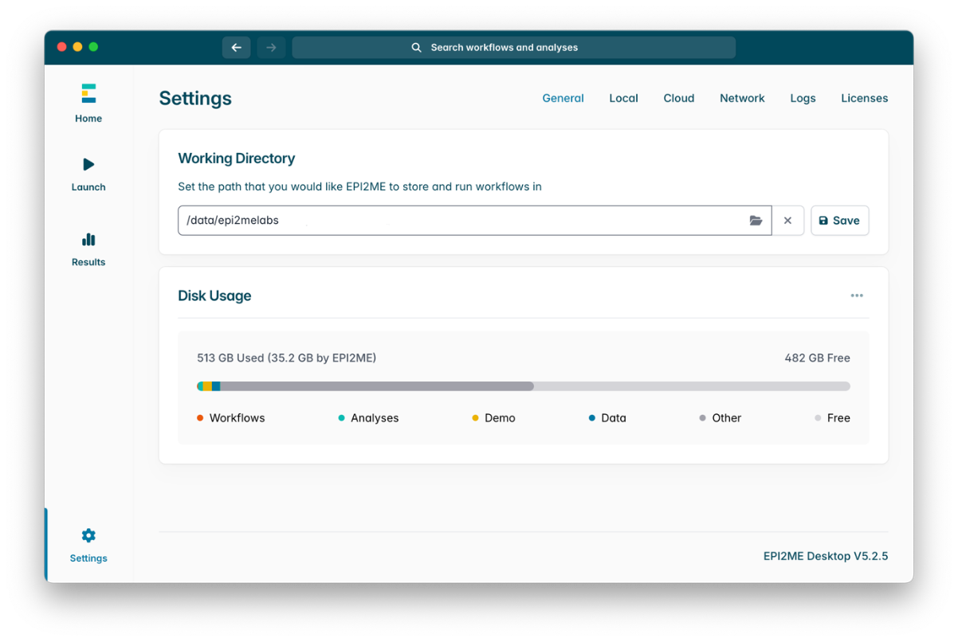
The wf-hereditary-cancer analysis workflow is distributed as a 2ME file which is distributed via CloudHub. Please see the Before getting started: Data bundle and workflow setup section of the protocol for instructions on how to gain access to and download these files.
Running wf-hereditary cancer for the first time: installing the workflow 2ME package
If you are running wf-hereditary-cancer for the first time, follow these steps to install the workflow 2ME package:
1. Open the EPI2ME desktop application and select Launch from the menu on the left.
2. Select Import workflow on the right of the screen, and in the dropdown, select Import a 2ME file.
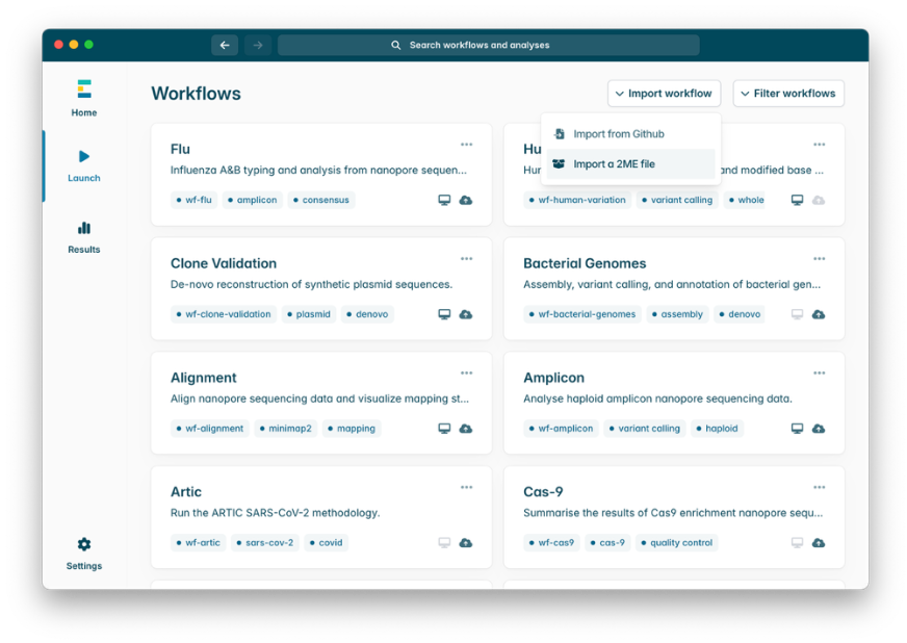
3. In the pop-up window, ensure Select a file is selected, and then click Select a path to navigate to the location of the downloaded 2ME file.
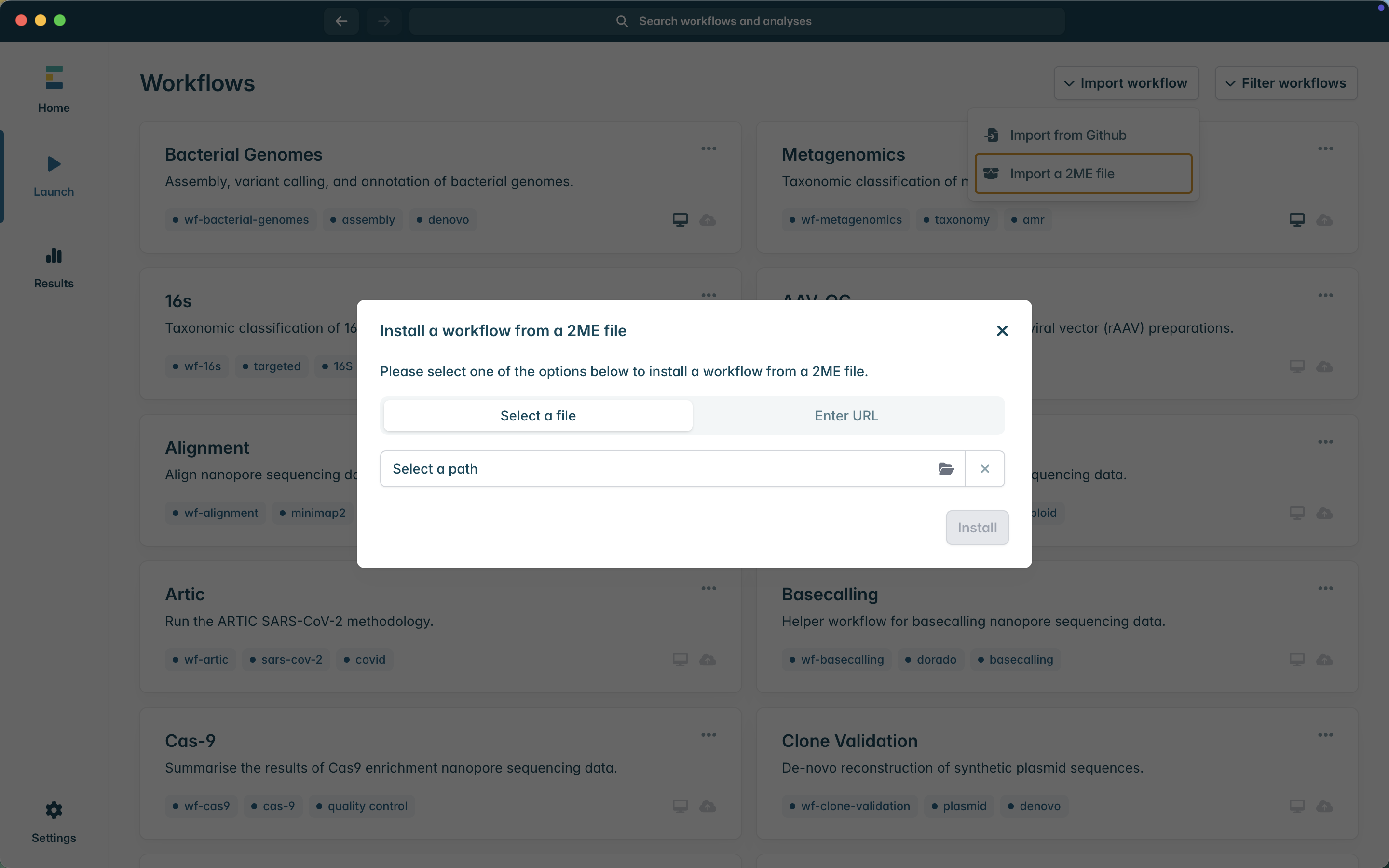
4. Click Install. The application will then install the workflow. This may take a few minutes as it will install the required containers.
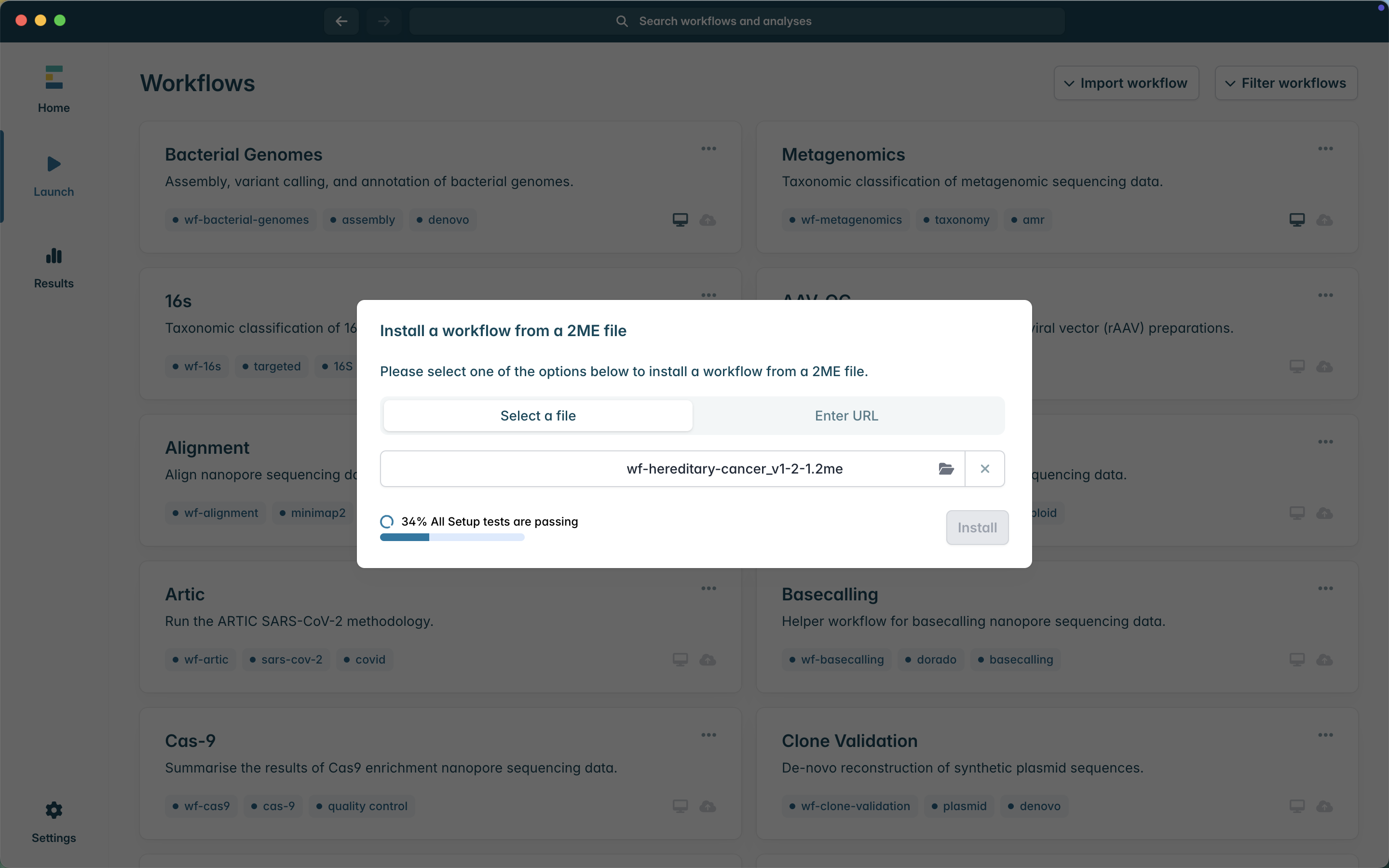
5. Successful installation will be indicated with a message. Close the pop-up. The workflow is now installed and ready to use.
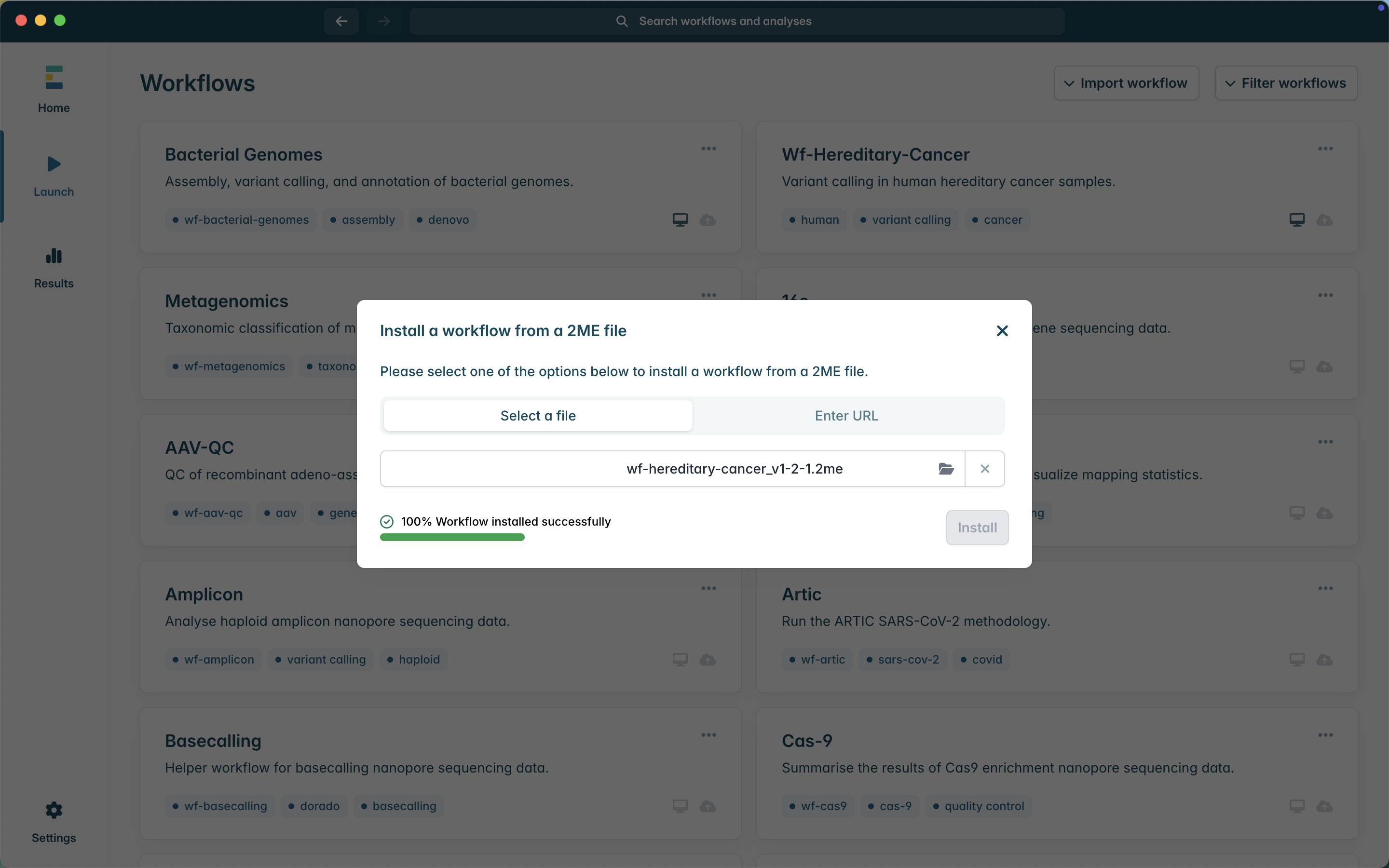
6. If you wish to test the installation using a small demo dataset provided with the workflow, select wf-hereditary-cancer under the Installed workflows tab. Then, under the Options drop-down menu, select Run demo analysis. Then select Launch.
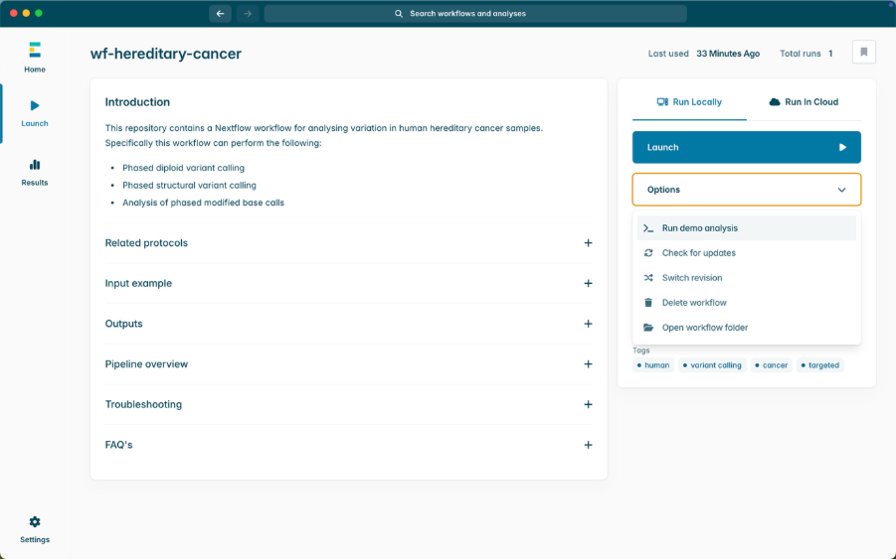
Analysis with wf-hereditary-cancer
Running the workflow:
1. Launch the EPI2ME Desktop App.
2. Select wf-hereditary-cancer under the installed workflows tab. Then select Launch.
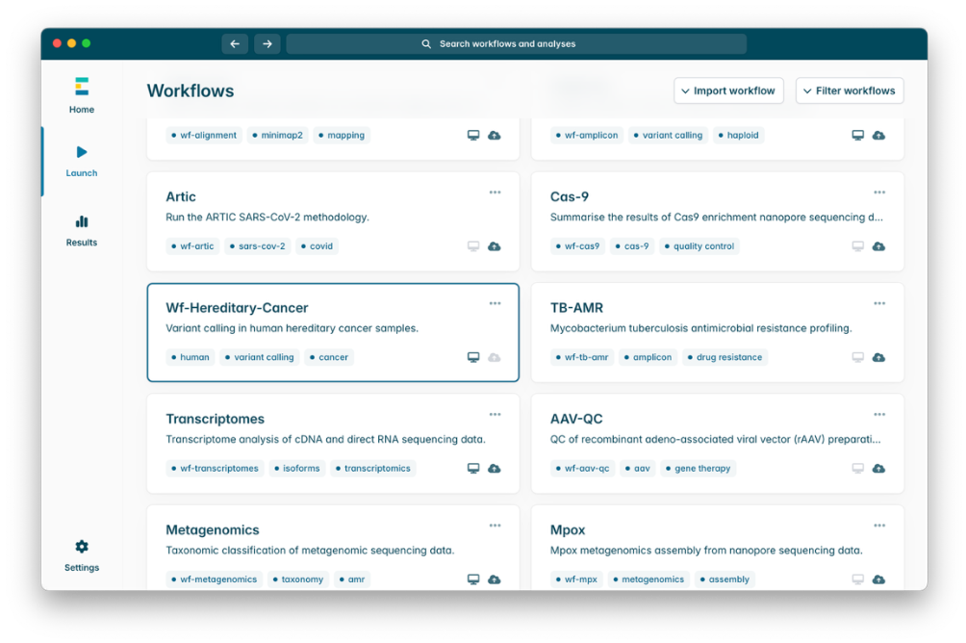
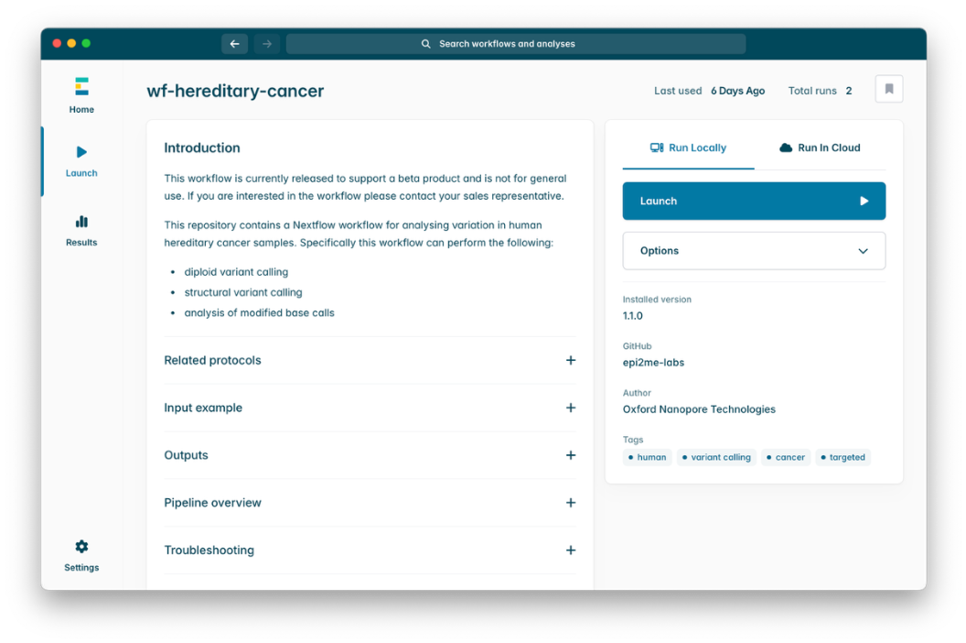
3. Under Main options, enter the path to the folder containing BAMs for the sample (e.g. barcode01). Please note that the workflow should be run separately for each sample. If you wish to use a name different from the folder name in your final output report, provide the new name in the Sample Name field.
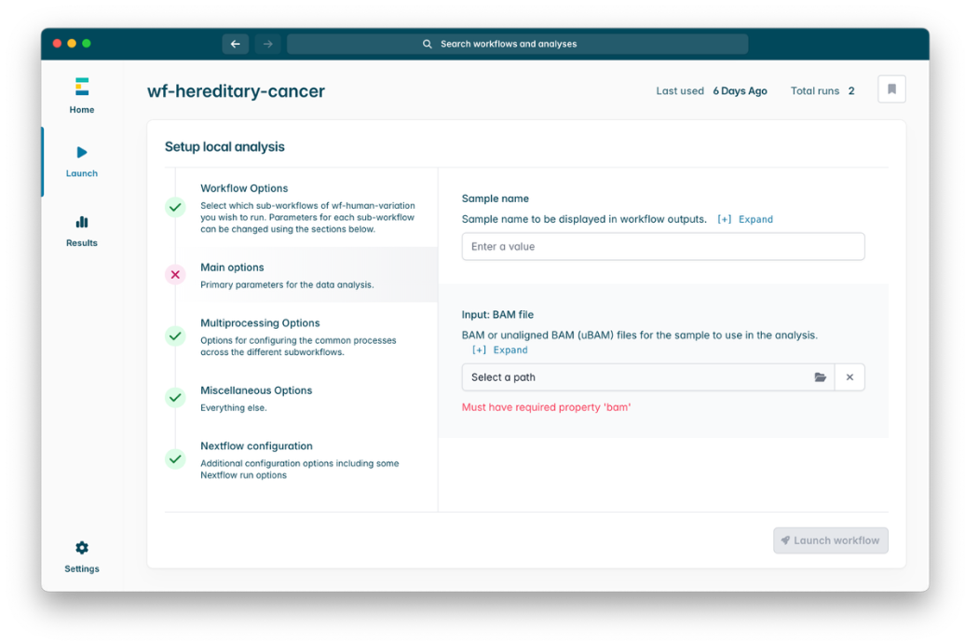
4. Click Launch workflow.
The default values under Multiprocessing Options and Nextflow configuration are suitable for running the workflow on Oxford Nanopore’s PromethION and GridION instruments. We recommend leaving all other parameters at the default values.
Output files
wf-hereditary-cancer produces several interactive HTML reports with information on data quality metrics, coverage across target regions, and variants detected. The workflow also outputs additional files that can be used for downstream analysis and exploration, including variant calls (.vcf) for tertiary variant annotation analysis and haplotagged alignment and methylation files (.bam, .bedmethyl) for inspecting the data on a genome browser.
12. Flow cell reuse and returns
We do not recommend washing and reusing your flow cells for this method.
Due to the extended sequencing time, and the multiple flow cell washes and library reloads, we do not recommend re-using the flow cells used in this method.
Re-using these flow cells for subsequent sequencing experiments may result in insufficient data generation for analysis.
Follow the returns procedure to send back flow cells to Oxford Nanopore for recycling.
Instructions for returning flow cells can be found here.
If you encounter issues or have questions about your sequencing experiment, please refer to the Troubleshooting Guide that can be found in the online version of this protocol.
13. Troubleshooting for Hereditary Cancer Panel
Live basecalling was not enabled during my sequencing run. What can I do?
Post-run basecalling
If the data was not live basecalled with the recommended HAC model during sequencing, it can be basecalled using the standalone version of the Dorado software. To do so using the command line, please follow the instructions on GitHub page.
You can also basecall your data using our wf-basecalling workflow, available for command line use and via the EPI2ME Desktop App.
Please note that we strongly recommend live basecalling. Post-run basecalling has not been validated at Oxford Nanopore for this Hereditary Cancer Profiling workflow.
Issues during DNA extraction and library preparation
Below is a list of the most commonly encountered issues, with some suggested causes and solutions.
We also have an FAQ section available on the Nanopore Community Support section.
If you have tried our suggested solutions and the issue still persists, please contact Technical Support via email (support@nanoporetech.com) or via LiveChat in the Nanopore Community.
Low sample quality
| Observation | Possible cause | Comments and actions |
|---|---|---|
| Low DNA purity (Nanodrop reading for DNA OD 260/280 is <1.8 and OD 260/230 is <2.0–2.2) | The DNA extraction method does not provide the required purity | The effects of contaminants are shown in the Contaminants Know-how piece. Please try an alternative extraction method that does not result in contaminant carryover. Consider performing an additional AMPure bead clean-up step. |
Low DNA recovery after AMPure bead clean-up
| Observation | Possible cause | Comments and actions |
|---|---|---|
| Low recovery | DNA loss due to a lower than intended AMPure beads-to-sample ratio | 1. AMPure beads settle quickly, so ensure they are well resuspended before adding them to the sample. 2. When the AMPure beads-to-sample ratio is lower than 0.4:1, DNA fragments of any size will be lost during the clean-up. |
| Low recovery | DNA fragments are shorter than expected | The lower the AMPure beads-to-sample ratio, the more stringent the selection against short fragments. Please always determine the input DNA length on an agarose gel (or other gel electrophoresis methods) and then calculate the appropriate amount of AMPure beads to use. 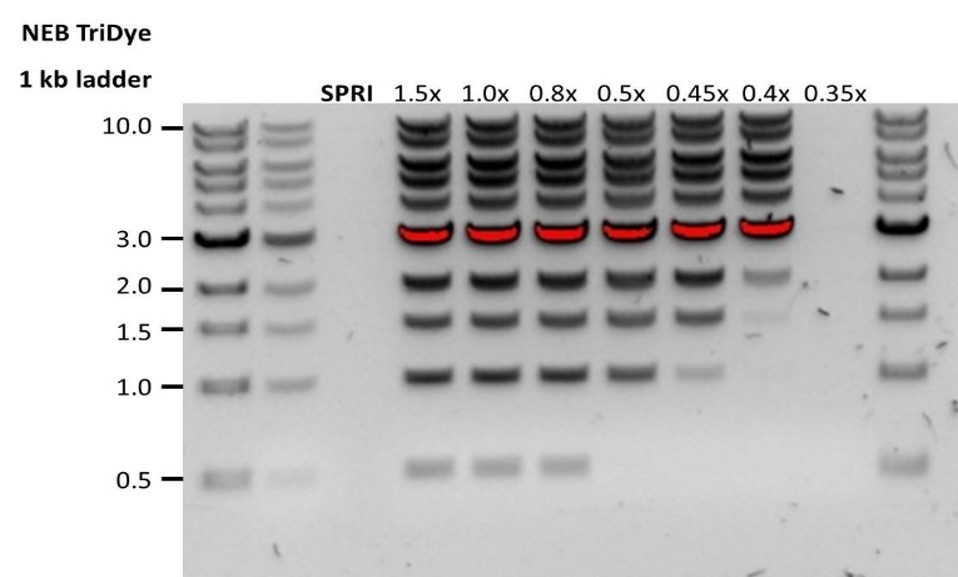 |
| Low recovery after end-prep | The wash step used ethanol <70% | DNA will be eluted from the beads when using ethanol <70%. Make sure to use the correct percentage. |
Issues during the sequencing run
Below is a list of the most commonly encountered issues, with some suggested causes and solutions.
We also have an FAQ section available on the Nanopore Community Support section.
If you have tried our suggested solutions and the issue still persists, please contact Technical Support via email (support@nanoporetech.com) or via LiveChat in the Nanopore Community.
Fewer pores at the start of sequencing than after Flow Cell Check
| Observation | Possible cause | Comments and actions |
|---|---|---|
| MinKNOW reported a lower number of pores at the start of sequencing than the number reported by the Flow Cell Check | An air bubble was introduced into the nanopore array | After the Flow Cell Check it is essential to remove any air bubbles near the priming port before priming the flow cell. If not removed, the air bubble can travel to the nanopore array and irreversibly damage the nanopores that have been exposed to air. The best practice to prevent this from happening is demonstrated in this video how to load a PromethION Flow Cell. |
| MinKNOW reported a lower number of pores at the start of sequencing than the number reported by the Flow Cell Check | The flow cell is not correctly inserted into the device | Stop the sequencing run, remove the flow cell from the sequencing device and insert it again, checking that the flow cell is firmly seated in the device and that it has reached the target temperature. If applicable, try a different position on the device (GridION/PromethION). |
| MinKNOW reported a lower number of pores at the start of sequencing than the number reported by the Flow Cell Check | Contaminations in the library damaged or blocked the pores | The pore count during the Flow Cell Check is performed using the QC DNA molecules present in the flow cell storage buffer. At the start of sequencing, the library itself is used to estimate the number of active pores. Because of this, variability of about 10% in the number of pores is expected. A significantly lower pore count reported at the start of sequencing can be due to contaminants in the library that have damaged the membranes or blocked the pores. Alternative DNA/RNA extraction or purification methods may be needed to improve the purity of the input material. The effects of contaminants are shown in the Contaminants Know-how piece. Please try an alternative extraction method that does not result in contaminant carryover. |
MinKNOW script failed
| Observation | Possible cause | Comments and actions |
|---|---|---|
| MinKNOW shows "Script failed" | Restart the computer and then restart MinKNOW. If the issue persists, please collect the MinKNOW log files and contact Technical Support. If you do not have another sequencing device available, we recommend storing the flow cell and the loaded library at 4°C and contact Technical Support for further storage guidance. |
Pore occupancy below 40%
| Observation | Possible cause | Comments and actions |
|---|---|---|
| Pore occupancy <40% | Not enough library was loaded on the flow cell | For the human genome sequencing protocols, 250-300 ng of good quality library should be loaded on to an R10.4.1 flow cell to keep pore occupancy high. |
| Pore occupancy close to 0 | The Ligation Sequencing Kit was used, and ethanol was used instead of LFB or SFB at the wash step after sequencing adapter ligation | Ethanol can denature the motor protein on the sequencing adapters. Make sure the LFB or SFB buffer was used after ligation of sequencing adapters. |
| Pore occupancy close to 0 | No tether on the flow cell | Tethers are adding during flow cell priming (FCT tube). Make sure FCT was added to FCF before priming. |
Shorter than expected read length
| Observation | Possible cause | Comments and actions |
|---|---|---|
| Shorter than expected read length | Unwanted fragmentation of DNA sample | Read length reflects input DNA fragment length. Input DNA can be fragmented during extraction and library prep. 1. Please review the Extraction Methods in the Nanopore Community for best practice for extraction. 2. Visualise the input DNA fragment length distribution on an agarose gel before proceeding to the library prep. 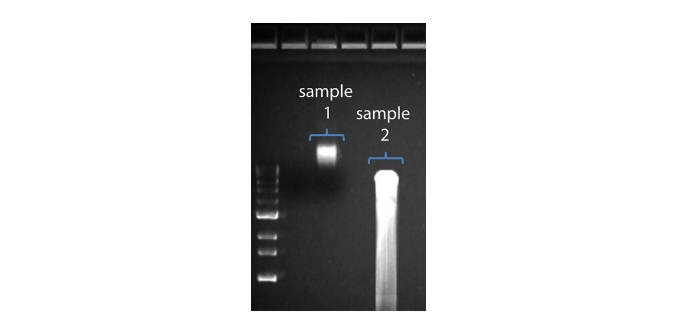 In the image above, Sample 1 is of high molecular weight, whereas Sample 2 has been fragmented. In the image above, Sample 1 is of high molecular weight, whereas Sample 2 has been fragmented.3. During library prep, avoid pipetting and vortexing when mixing reagents. Flicking or inverting the tube is sufficient. |
Large proportion of unavailable pores
| Observation | Possible cause | Comments and actions |
|---|---|---|
Large proportion of unavailable pores (shown as blue in the channels panel and pore activity plot) 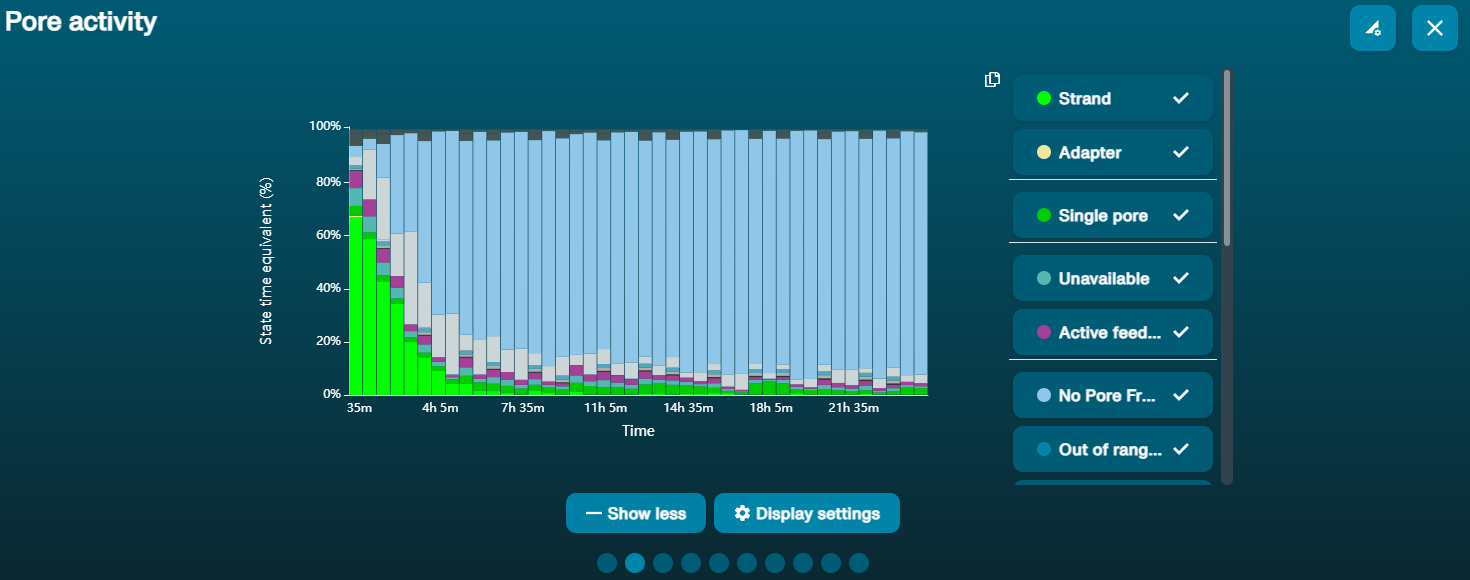 The pore activity plot above shows an increasing proportion of "unavailable" pores over time. The pore activity plot above shows an increasing proportion of "unavailable" pores over time. | Contaminants are present in the sample | Some contaminants can be cleared from the pores by the unblocking function built into MinKNOW. If this is successful, the pore status will change to "sequencing pore". If the portion of unavailable pores stays large or increases: A nuclease flush using the Flow Cell Wash Kit (EXP-WSH004) can be performed. |
Large proportion of inactive pores
| Observation | Possible cause | Comments and actions |
|---|---|---|
| Large proportion of inactive/unavailable pores (shown as light blue in the channels panel and pore activity plot. Pores or membranes are irreversibly damaged) | Air bubbles have been introduced into the flow cell | Air bubbles introduced through flow cell priming and library loading can irreversibly damage the pores. Watch the [how to load a PromethION Flow Cell video for best practice. |
| Large proportion of inactive/unavailable pores | Certain compounds co-purified with DNA | Known compounds, include polysaccharides. 1. Clean-up using the QIAGEN PowerClean Pro kit. 2. Perform a whole genome amplification with the original gDNA sample using the QIAGEN REPLI-g kit. |
| Large proportion of inactive/unavailable pores | Contaminants are present in the sample | The effects of contaminants are shown in the Contaminants Know-how piece. Please try an alternative extraction method that does not result in contaminant carryover. |
Temperature fluctuation
| Observation | Possible cause | Comments and actions |
|---|---|---|
| Temperature fluctuation | The flow cell has lost contact with the device | Check that there is a heat pad covering the metal plate on the back of the flow cell. Re-insert the flow cell and press it down to make sure the connector pins are firmly in contact with the device. If the problem persists, please contact Technical Services. |
Failed to reach target temperature
| Observation | Possible cause | Comments and actions |
|---|---|---|
| MinKNOW shows "Failed to reach target temperature" | The instrument was placed in a location that is colder than normal room temperature, or a location with poor ventilation (which leads to the flow cells overheating) | MinKNOW has a default timeframe for the flow cell to reach the target temperature. Once the timeframe is exceeded, an error message will appear and the sequencing experiment will continue. However, sequencing at an incorrect temperature may lead to a decrease in throughput and lower q-scores. Please adjust the location of the sequencing device to ensure that it is placed at room temperature with good ventilation, then re-start the process in MinKNOW. |
